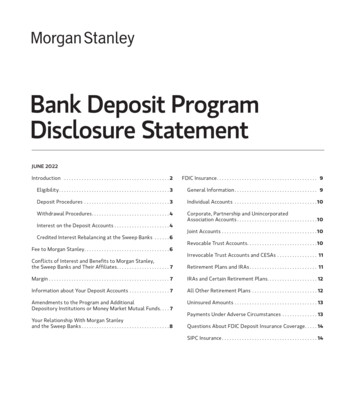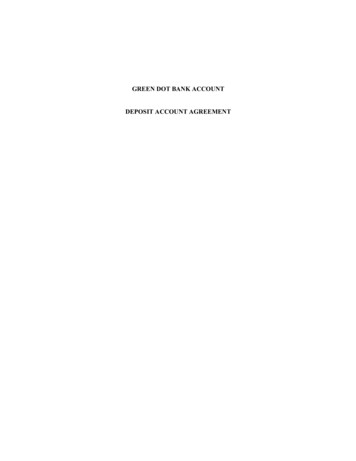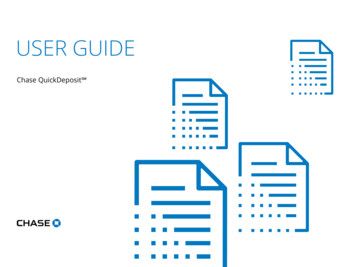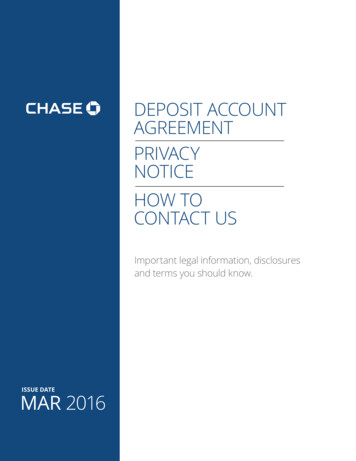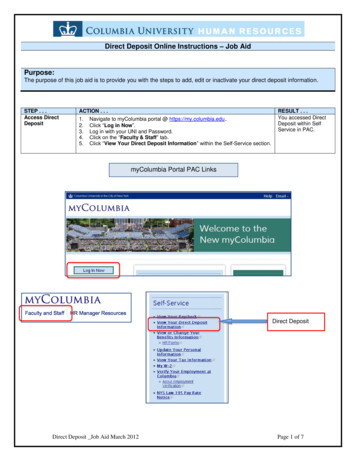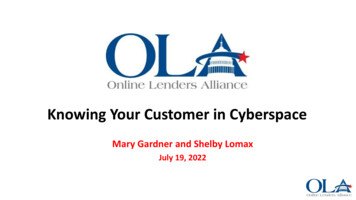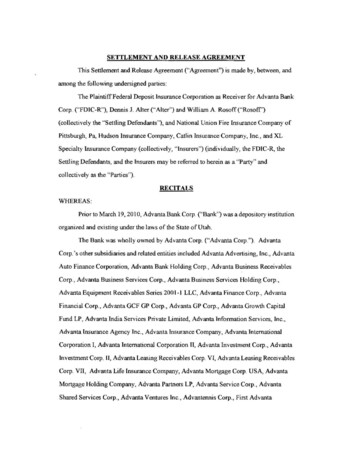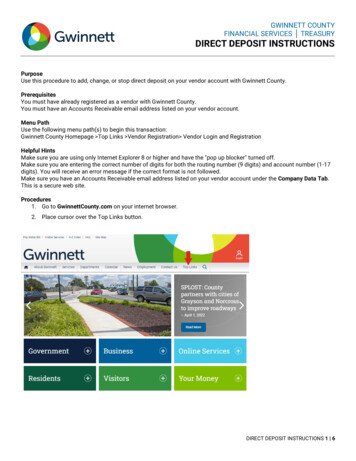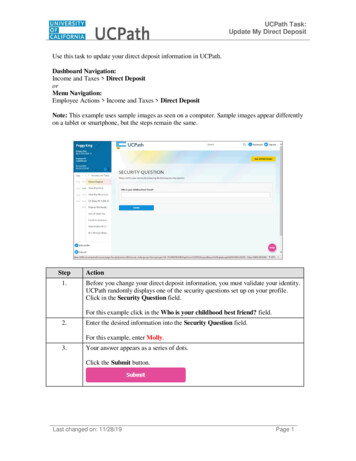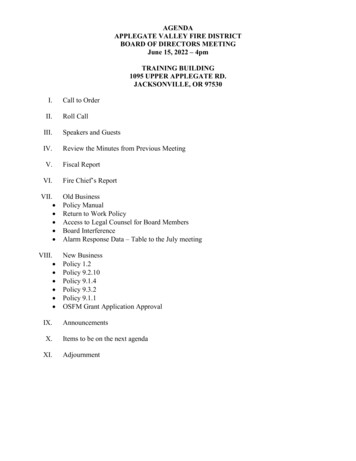
Transcription
Customer Identification ProgramCUSTOMER IDENTIFICATION PROGRAMObjective: Assess the bank’s compliance with the BSA regulatory requirements for theCustomer Identification Program (CIP).Regulatory Requirements for Customer Identification ProgramsThis section outlines the regulatory requirements for banks in 12 CFR Chapters I through III andVII, and 31 CFR Chapter X regarding CIPs. Specifically, this section covers: 12 CFR 21.21(c)(2) 12 CFR 208.63(b)(2), 12 CFR 211.5(m)(2), 12 CFR 211.24(j)(2) 12 CFR 326.8(b)(2) 12 CFR 748.2(b)(2) 31 CFR 1020.220A bank, including certain domestic subsidiaries, 1 must have a written CIP 2 that is appropriate forits size and type of business and that includes certain minimum requirements. The CIP must beincorporated into the bank’s BSA/AML compliance program, 3 which is subject to approval bythe bank’s board of directors. 4 Minor weaknesses, deficiencies, and technical violations aloneare not indicative of an inadequate CIP.Identity Verification ProceduresThe CIP must include risk-based procedures for verifying the identity of each customer to theextent reasonable and practicable. 5 The procedures must enable the bank to form a reasonablebelief that it knows the true identity of each customer and be based on the bank’s assessment ofrelevant risks, including: The types of accounts maintained by the bank. The bank’s methods of opening accounts.See OCC 12 CFR 5.34(e)(3) and 5.38(e)(3) (examination and supervision of operating subsidiaries of nationalbanks and federal savings associations). See also FinCEN, Federal Reserve, FDIC, NCUA, OCC, OTS, Treasury(April 28, 2005), “Interagency Interpretive Guidance on Customer Identification Program Requirements underSection 326 of the USA PATRIOT Act,” Definition of “bank” FAQ #3. The FDIC will evaluate each subsidiaryrelationship in the context of the bank’s safety and soundness before determining whether the CIP applies to thebank’s subsidiaries. Wholly- or majority-owned credit union service organizations (CUSOs) may be consideredsubsidiaries of the credit union owner; however, as separate legal entities, the NCUA has no direct regulatoryauthority over CUSOs.212 CFR 208.63(b)(2), 211.5(m)(2), and 211.24(j)(2) (Federal Reserve); 12 CFR 326.8(b)(2) (FDIC); 12 CFR748.2(b)(2) (NCUA); 12 CFR 21.21(c)(2) (OCC); and 31 CFR 1020.220 (FinCEN).312 CFR 208.63(b)(2), 211.5(m)(2), and 211.24(j)(2) (Federal Reserve); 12 CFR 326.8(b)(2) (FDIC); 12 CFR748.2(b)(2) (NCUA); 12 CFR 21.21(c)(2) (OCC); and 31 CFR 1020.220 (FinCEN).412 CFR 208.63(b), 211.5(m), and 211.24(j) (Federal Reserve); 12 CFR 326.8(b) (2) (FDIC); 12 CFR 748.2(b)(NCUA); 12 CFR 21.21 (OCC).531 CFR 1020.220(a)(2).1FFIEC BSA/AML Examination Manual1February 2021
Customer Identification Program The types of identifying information available. The bank’s size, location, and customer base. 6For purposes of the CIP rule, an “account” is a formal banking relationship established toprovide or engage in services, dealings, or other financial transactions, including a depositaccount, a transaction or asset account, a credit account, or other extension of credit. An accountincludes a relationship established to provide a safety deposit box or other safekeeping services,or cash management, custodian, and trust services. 7An account does not include: 8 A product or service where a formal banking relationship is not established with a person,such as check-cashing, wire transfer, or sale of a check or money order; An account that the bank acquires through an acquisition, merger, purchase of assets, orassumption of liabilities; or An account opened for the purpose of participating in an employee benefit planestablished under the Employee Retirement Income Security Act of 1974.The CIP rule applies to a customer, 9 which means: A person that opens a new account; and An individual who opens a new account for:o An individual who lacks legal capacity, such as a minor; oro An entity that is not a legal person, such as a civic club.A customer does not include a person who does not receive banking services, such as a personwhose loan application is denied 10 or a person that has an existing account with the bank,provided that the bank has a reasonable belief that it knows the true identity of the person. 11Also excluded from the definition of customer are financial institutions regulated by a federalfunctional regulator or a bank regulated by a state bank regulator, governmental entities, andpublicly traded companies as described in 31 CFR 1020.315(b)(2) through (b)(4). 126Id.31 CFR 1020.100(a)(1).831 CFR 1020.100(a)(2).931 CFR 1020.100(b).10FinCEN, Federal Reserve, FDIC, NCUA, OCC, OTS, Treasury (April 28, 2005), “Interagency InterpretiveGuidance on Customer Identification Program Requirements under Section 326 of the USA PATRIOT Act,”Definition of “account” FAQ #1.1131 CFR 1020.100(b)(2)(iii). FinCEN, Federal Reserve, FDIC, NCUA, OCC, OTS, Treasury (April 28, 2005),“Interagency Interpretive Guidance on Customer Identification Program Requirements under Section 326 of theUSA PATRIOT Act,” Person with an existing account FAQ #3. A bank can demonstrate that it has “a reasonablebelief” by showing that prior to the issuance of the final CIP rule, it had comparable procedures in place to verify theidentity of persons that had accounts with the bank as of October 1, 2003, though the bank may not have gatheredthe very same information about such persons as required by the final CIP rule.1231 CFR 1020.100(b)(2).7FFIEC BSA/AML Examination Manual2February 2021
Customer Identification ProgramCustomer Information RequiredThe CIP must contain account-opening procedures detailing the identifying information to obtainfrom each customer. 13 At a minimum, the bank must obtain the following identifyinginformation from each customer before opening the account: Name, Date of birth for an individual, Address, 14 and Identification number. 15The CIP rule provides for an exception for opening an account for a customer who has appliedfor a tax identification number (TIN) and an alternative process for obtaining CIP identifyinginformation for credit card accounts. The exception permits the bank to open an account for a customer who has applied for aTIN, but does not yet have a TIN. In this case, the bank’s CIP must include proceduresto confirm that the application was filed before the customer opens the account and toobtain the TIN within a reasonable period of time after the account is opened. 16 For a credit card account, the bank may also obtain CIP identifying information about thecustomer by acquiring it from a third-party source prior to extending credit to thecustomer. 1731 CFR 1020.220(a)(2)(i). Given the definition of customer, when an individual opens a new account for anentity that is not a legal person or for another individual who lacks legal capacity, the identifying information for theindividual opening the account must be obtained. In contrast, when an account is opened by an agent on behalf ofanother person, the bank must obtain the identifying information of the person on whose behalf the account is beingopened, as this person is defined as the customer.1431 CFR 1020.220(a)(2)(i)(A)(3). For an individual: a residential or business street address, or if the individualdoes not have such an address, an Army Post Office (APO) or Fleet Post Office (FPO) box number, or theresidential or business street address of next of kin or of another contact individual. For a “person” other than anindividual (such as a corporation, partnership, or trust): a principal place of business, local office, or other physicallocation. FinCEN, Federal Reserve, FDIC, NCUA, OCC, OTS, Treasury (April 28, 2005), “Interagency InterpretiveGuidance on Customer Identification Program Requirements under Section 326 of the USA PATRIOT Act,”Information required FAQ #1, further explains that for an individual, the description of the customer’s physicallocation will suffice.15An identification number for a U.S. person is a taxpayer identification number (TIN) (or evidence of anapplication for one consistent with 31 CFR 1020.220(a)(2)(i)(B)). An identification number for a non-U.S. person isone or more of the following: a TIN (or evidence of an application for one consistent with 31 CFR1020.220(a)(2)(i)(B)); a passport number and country of issuance; an alien identification card number; or a numberand country of issuance of any other government-issued document evidencing nationality or residence and bearing aphotograph or similar safeguard. When opening an account for a foreign business or enterprise that does not havean identification number, the bank must request alternative government-issued documentation certifying theexistence of the business or enterprise. TINs are described in section 6109 of the Internal Revenue Code (26 USC6109) and the IRS regulations implementing that section (26 CFR Part 301.6109-1) (e.g., Social Security number(SSN), individual taxpayer identification number (ITIN), or employer identification number (EIN)).1631 CFR 1020.220(a)(2)(i)(B).1731 CFR 1020.220(a)(2)(i)(C).13FFIEC BSA/AML Examination Manual3February 2021
Customer Identification ProgramBased on its BSA/AML risk assessment, a bank may require identifying information, in additionto the required information, for certain customers or product lines. 18Customer VerificationThe CIP must contain risk-based 19 procedures for verifying the identity of the customer within areasonable period of time after the account is opened. 20 The verification procedures must use the“information obtained in accordance with [31 CFR 1020.220(a)(2)(i)],” namely the identifyinginformation obtained by the bank. 21 A bank need not establish the accuracy of every element ofidentifying information obtained, but it must verify enough information to form a reasonablebelief that it knows the true identity of the customer. 22 The bank’s procedures must describewhen it uses documents, non-documentary methods, or a combination of both methods to verifythe identity of its customers. 23Verification Through DocumentsA bank relying on documents to verify a customer’s identity must have procedures that set forththe documents that the bank will use. 24 The CIP rule gives examples of the types of documentsthat may be used to verify a customer’s identity. The rule reflects the federal banking agencies’expectations that, for most customers who are individuals, banks review an unexpiredgovernment-issued form of identification evidencing a customer’s nationality or residence andbearing a photograph or similar safeguard; examples include a driver’s license or passport.However, other forms of identification may be used if they enable the bank to form a reasonablebelief that it knows the true identity of the customer. Given the availability of counterfeit andfraudulently obtained documents, a bank is encouraged to review more than a single document toensure it can form a reasonable belief that it knows the true identity of the customer.For a person other than an individual (such as a corporation, partnership, or trust), documentsmay include those showing the legal existence of the entity, such as certified articles ofincorporation, an unexpired government-issued business license, a partnership agreement, or atrust instrument. 25Verification Through Non-Documentary MethodsA bank using non-documentary methods to verify a customer’s identity must have proceduresthat set forth the methods the bank uses. 26 Non-documentary methods may include contacting acustomer; independently verifying the customer’s identity through the comparison of informationFinCEN, Federal Reserve, FDIC, NCUA, OCC, OTS, Treasury (April 28, 2005), “Interagency InterpretiveGuidance on Customer Identification Program Requirements under Section 326 of the USA PATRIOT Act,”Definition of “customer” FAQs #7, 9, 10.1931 CFR 1020.220(a)(2).2031 CFR 1020.220(a)(2)(ii).21Id.22FinCEN, Federal Reserve, FDIC, NCUA, OCC, OTS, Treasury (April 28, 2005), “Interagency InterpretiveGuidance on Customer Identification Program Requirements under Section 326 of the USA PATRIOT Act,”Customer verification FAQ #1.2331 CFR 1020.220(a)(2)(ii).2431 CFR 1020.220(a)(2)(ii)(A).2531 CFR 1020.220(a)(2)(ii)(A)(2).2631 CFR 1020.220(a)(2)(ii)(B).18FFIEC BSA/AML Examination Manual4February 2021
Customer Identification Programprovided by the customer with information obtained from a consumer reporting agency, publicdatabase, or other source; checking references with other financial institutions; and obtaining afinancial statement. 27If the bank uses non-documentary methods to verify a customer’s identity, the bank’s proceduresmust address situations in which an individual is unable to present an unexpired governmentissued identification document that bears a photograph or similar safeguard; the bank is notfamiliar with the documents presented; the account is opened without obtaining documents; thecustomer opens the account without appearing in person at the bank; and where the bank isotherwise presented with circumstances that increase the risk that the bank will be unable toverify the true identity of a customer through documents. 28Additional Verification for Certain CustomersThe CIP must address situations in which, based on its risk assessment of a new account openedby a customer that is not an individual, the bank will obtain information about individuals withauthority or control over such account, including signatories, in order to verify the customer’sidentity. This verification method applies only when the bank cannot verify the customer’s trueidentity using documents or non-documentary methods. 29Lack of VerificationThe CIP must also have procedures 30 for responding to circumstances in which the bank cannotform a reasonable belief that it knows the true identity of the customer. These procedures shoulddescribe: When the bank should not open an account; The terms under which a customer may use an account while the bank attempts to verifythe customer’s identity; When the bank should close an account, after attempts to verify a customer’s identityhave failed; and When the bank should file a suspicious activity report (SAR) in accordance withapplicable law and regulation.Recordkeeping and Retention RequirementsThe bank’s CIP must include procedures for making and maintaining a record of all informationobtained to identify and verify a customer’s identity. 31 At a minimum, the bank must retain allidentifying information (name, date of birth for an individual, address, identification number, and31 CFR 1020.220(a)(2)(ii)(B)(1).31 CFR 1020.220(a)(2)(ii)(B)(2).2931 CFR 1020.220(a)(2)(ii)(C).3031 CFR 1020.220(a)(2)(iii).3131 CFR 1020.220(a)(3).2728FFIEC BSA/AML Examination Manual5February 2021
Customer Identification Programany other identifying information obtained under 31 CFR 1020.220(a)(2)(i) 32) at accountopening for CIP purposes for a period of five years after the account is closed. For credit cards,the retention period is five years after the account is closed or becomes dormant. 33A bank may keep copies of identifying documents that it uses to verify a customer’s identity;however, the CIP rule does not require it. A bank’s verification procedures must be risk-basedand, in certain situations, keeping copies of identifying documents may be warranted. Inaddition, a bank may have procedures to keep copies of the documents for other purposes, forexample, to facilitate investigating potential fraud. If the bank retains copies of identifyingdocuments in lieu of a description, these documents must be retained in accordance with thegeneral recordkeeping requirements in 31 CFR 1010.430, “Nature of Records and RetentionPeriod.” Nonetheless, a bank should not improperly use any document containing a picture of anindividual, such as a driver’s license, in connection with any aspect of a credit transaction. 34The bank must also keep a description of the following for five years after the record is made: 35 Any document that was relied on to verify identity, noting the type of document, anyidentification number contained in the document, the place of issuance, and, if any, thedate of issuance and expiration date; The methods and the results of any measures undertaken to verify the identity of thecustomer using non-documentary methods or additional verification procedures forcertain customers; and The resolution of any substantive discrepancy discovered when verifying the identifyinginformation obtained.Comparison with Government ListsThe CIP must include procedures for determining whether the customer appears on any list ofknown or suspected terrorists or terrorist organizations issued by any federal government agencyand designated as such by Treasury in consultation with the federal functional regulators. 36 Theprocedures must require the bank to make such a determination within a reasonable period oftime after the account is opened, or earlier, if required by another federal law or regulation orfederal directive issued in connection with the applicable list. The procedures must also requirethe bank to follow all federal directives issued in connection with such lists. 37 Banks willFinCEN, Federal Reserve, FDIC, NCUA, OCC, OTS, Treasury (April 28, 2005), “Interagency InterpretiveGuidance on Customer Identification Program Requirements under Section 326 of the USA PATRIOT Act,”Retention of records FAQ #2.3331 CFR 1020.220(a)(3).34FinCEN, Federal Reserve, FDIC, NCUA, OCC, OTS, Treasury (April 28, 2005), “Interagency InterpretiveGuidance on Customer Identification Program Requirements under Section 326 of the USA PATRIOT Act,”Required records FAQ #2.3531 CFR 1020.220(a)(3)(i)(B)-(D).3631 CFR 1020.220(a)(4).37Id.32FFIEC BSA/AML Examination Manual6February 2021
Customer Identification Programreceive notification by way of separate guidance regarding the list that must be consulted forpurposes of this provision. 38As of the publication date of this Manual, no designated government lists for CIP purposes exist.Checking of customers against Office of Foreign Assets Control (OFAC) lists and 31 CFR1010.520 (commonly referred to as section 314(a) requests) remain separate and distinctrequirements.Adequate Customer NoticeThe CIP must include procedures for providing bank customers with adequate notice that thebank is requesting information to verify their identities. 39 Notice is adequate if the bankgenerally describes the identification requirements of the CIP rule and provides the notice in amanner reasonably designed to ensure that a customer is able to view or otherwise receive thenotice before the account is opened. 40 Depending on the manner in which an account is opened,examples of adequate notice may include posting a notice in the lobby or on the bank’s website,including a notice with account application documents, or providing other written or oral notice.The sample language below is provided in the regulation: 41Important Information About Procedures for Opening a New AccountTo help the government fight the funding of terrorism and money launderingactivities, Federal law requires all financial institutions to obtain, verify, andrecord information that identifies each person who opens an account.What this means for you: When you open an account, we will ask for your name,address, date of birth, and other information that will allow us to identify you.We may also ask to see your driver’s license or other identifying documents.Reliance on Another Financial InstitutionThe bank’s CIP may include procedures specifying when a bank will rely on the performance byanother financial institution (including an affiliate) of any procedures of the bank’s CIP withrespect to any customer of the bank that is opening, or has opened, an account or has establisheda similar formal banking or business relationship with the other financial institution to provide orengage in services, dealings, or other financial transactions, provided that: Such reliance is reasonable under the circumstances; The other, relied-upon financial institution is subject to a rule implementing 31 USC5318(h) and is regulated by a federal functional regulator; 42 andOCC, Federal Reserve, FDIC, OTS, NCUA, FinCEN (May 9, 2003), “Customer Identification Programs forBanks, Savings Associations, Credit Unions and Certain Non-Federally Regulated Banks,” 68 Fed. Reg. 25090,25103.3931 CFR 1020.220(a)(5)(i).4031 CFR 1020.220(a)(5)(ii).4131 CFR 1020.220(a)(5)(iii).4231 CFR 1010.100(r). Federal functional regulator means: Federal Reserve, FDIC, NCUA, OCC, U.S. Securitiesand Exchange Commission (SEC), or U.S. Commodity Futures Trading Commission (CFTC).38FFIEC BSA/AML Examination Manual7February 2021
Customer Identification Program The other financial institution enters into a contract requiring it to certify annually to thebank that it has implemented its AML program, and that it will perform (or its agent willperform) the specified requirements of the bank’s CIP. 43ExemptionsThe appropriate federal functional regulator, with the concurrence of FinCEN on behalf of theSecretary of the Treasury, may, by order or regulation, exempt any bank or type of account fromthe requirements of this section. 44 The federal banking agencies, with FinCEN’s concurrence,have granted a CIP exemption for loans extended by banks and their subsidiaries to all customersto facilitate purchases of property and casualty insurance policies (referred to as premiumfinance loans). 45 The federal banking agencies found that the exemption is consistent with thepurposes of the BSA, based on FinCEN’s determination that premium finance loans present alow risk of money laundering or terrorist financing (ML/TF), and that this exemption isconsistent with safe and sound banking.Other Legal RequirementsNothing in the CIP rule relieves a bank of its obligation to comply with any other provision ofthe BSA, including provisions concerning information that must be obtained, verified, ormaintained in connection with any account or transaction. 46Use of Third PartiesThe CIP rule does not alter a bank’s authority to use a third party, such as an agent or serviceprovider, to perform services on its behalf. Therefore, a bank may arrange for a third party, suchas a car dealer or mortgage broker, acting as its agent in connection with a loan, to verify theidentity of its customer. 47 The bank can also arrange for a third party to maintain its records.However, as with other responsibilities performed by a third party, the bank is ultimatelyresponsible for compliance with the requirements of the CIP rule. Examiners should refer totheir agency’s relevant guidance and requirements for such third-party relationships.4831 CFR 1020.220(a)(6).31 CFR 1020.220(b).45Federal Reserve, FDIC, NCUA, OCC, FinCEN (October 5, 2020), “Order granting an exemption from customeridentification program requirements implementing section 326 of the USA PATRIOT Act, 31 U.S.C. 5318(l), forloans extended by banks (and their subsidiaries) subject to the jurisdiction of the Federal Banking Agencies to allcustomers to facilitate purchases of property and casualty insurance policies.”4631 CFR 1020.220(c).47Such third-party arrangements are contemplated in FinCEN, Federal Reserve, FDIC, NCUA, OCC, OTS,Treasury (April 28, 2005), “Interagency Interpretive Guidance on Customer Identification Program Requirementsunder Section 326 of the USA PATRIOT Act,” Customer notice FAQ #2.48Federal Reserve (December 5, 2013), SR 13-19 “Guidance on Managing Outsourcing Risk.” FDIC (June 6,2008), FIL-44-2008 “Guidance for Managing Third-Party Risk.” NCUA (December 2007), “Evaluating Third PartyRelationships.” OCC (October 30, 2013), Bulletin 2013-29 “Third Party Relationships: Risk ManagementGuidance;” and OCC (March 5, 2020), Bulletin 2020-10 “Third-Party Relationships: Frequently Asked Questions toSupplement OCC Bulletin 2013-29.”4344FFIEC BSA/AML Examination Manual8February 2021
Customer Identification ProgramAdditional ResourcesThe U.S. Department of the Treasury, FinCEN, and the federal banking agencies have issuedFrequently Asked Questions (FAQs), which may be revised periodically. 49 FinCEN and thefederal banking agencies have issued interagency guidance to issuing banks on applying CIPrequirements to holders of prepaid cards. 50 There is also guidance encouraging banks to usenon-documentary verification methods permitted by the CIP requirements for customers whocannot provide standard identification documents because of the effects of natural disasters. 51The FAQs, guidance, exceptive relief, and other related documents (e.g., the CIP rule) areavailable on the websites of FinCEN and the federal banking agencies.Examiner Assessment of the CIP ProcessExaminers should assess the adequacy of the bank’s policies, procedures, and processes (internalcontrols) related to the bank’s CIP. Specifically, examiners should determine whether theseinternal controls are designed to mitigate and manage ML/TF and other illicit financial activityrisks and comply with CIP requirements. Examiners may review other information, such asrecent independent testing or audit reports, to aid in their assessment of the bank’s CIP.Examiners should also consider general internal controls concepts, such as dual controls,segregation of duties, and management approval for certain actions, as they relate to the bank’sCIP. Other internal controls may include BSA compliance officer or other senior managementapproval for staff actions that deviate from the bank’s CIP policies, procedures, and processes.When assessing internal controls and CIP compliance, examiners should keep in mind that thebank may have limited instances of noncompliance with the CIP rule (such as isolated ortechnical violations) or minor deviations from the bank’s CIP policies, procedures, and processeswithout resulting in an inadequate CIP.Examiners should determine whether the bank’s internal controls for CIP are designed to assureongoing compliance with the requirements and are commensurate with the bank’s size orcomplexity and organizational structure. More information can be found in the Assessing theBSA/AML Compliance Program - BSA/AML Internal Controls section of this Manual.FinCEN, Federal Reserve, FDIC, NCUA, OCC, OTS, Treasury (April 28, 2005), “Interagency InterpretiveGuidance on Customer Identification Program Requirements under Section 326 of the USA PATRIOT Act.”50Federal Reserve, FDIC, FinCEN, NCUA, and OCC (March 21, 2016), “Interagency Guidance to Issuing Banks onApplying Customer Identification Program Requirements to Holders of Prepaid Cards.”51FDIC (August 29, 2017), FIL-38-2017 “Meeting the Financial Needs of Customers Affected by Hurricane Harveyand its Aftermath.” Federal Reserve (March 29, 2013), SR 13-6 “Supervisory Practices Regarding BankingOrganizations and their Borrowers and Other Customers Affected by a Major Disaster or Emergency.” NCUA(December 14, 2017), SL No. 17-02 “Examiner Guidance for Institutions Affected by a Major Disaster.” OCC(November 14, 2012), NR 2012-164 “Agencies Issue Supplemental Statement on Supervisory Practices RegardingFinancial Institutions and Borrowers Affected by Hurricane Sandy.”49FFIEC BSA/AML Examination Manual9February 2021
Customer Identification Program Examination and Testing ProceduresCUSTOMER IDENTIFICATION PROGRAM EXAMINATIONAND TESTING PROCEDURESObjective: Assess the bank’s compliance with the BSA regulatory requirements for theCustomer Identification Program (CIP).1. Verify that the bank has a written CIP appropriate for its size and type of business. Thewritten program must be included within the bank’s BSA/AML compliance program andmust contain procedures that address: Obtaining the required identifying information (including name, date of birth for anindividual, address, and identification number). Verifying the identity of each customer to the extent reasonable and practicable throughrisk-based procedures. Responding to circumstances in which the bank cannot form a reasonable belief that itknows the true identity of a customer, including determining when a suspicious activityreport (SAR) should be filed. Complying with recordkeeping requirements. Timely checking of new accounts against prescribed government lists, if applicable. Providing adequate customer notice. Relying on another financial institution that has an AML compliance program and isregulated by a federal functional regulator, if applicable.2. Verify that the bank establishes appropriate controls and review procedures for itsrelationships with third parties, if applicable. If the bank is using a third party, such as anagent or service provider, to perform elements of its CIP, determine whether the bank hasprocedures in place to monitor for and ensure adequate performance.3. Determine whether the bank’s CIP appropriately considers the types of accounts maintained;methods of account opening; the types of identifying information available; and the bank’ssize, location, and customer base.4. Select a sample of new accounts opened since the most recent examination to review forcompliance with the bank’s CIP. The sample should include a cross-section of accounts asindicated by the bank’s risk assessment (e.g., consumers and businesses, loans and deposits,credit card relationships, and accounts opened via U.S. mail and online). The sample shouldalso, on a risk basis, include the following: New accounts opened using the exception for customers that have applied for a TIN. New accounts opened using documentary methods, and new accounts opened using nondocumentary methods. New accounts identified by the bank as higher risk.FFIEC BSA/AML Examination Manual10February 2021
Customer Identification Program Examination and Testing Procedures New accounts opened with incomplete verification information, if applicable. New accounts opened by a third party as the bank’s
banks and federal savings associations). See also FinCEN, Federal Reserve, FDIC, NCUA, OCC, OTS, Treasury (April 28, 2005), "Interagency Interpretive Guidance on Customer Identification Program Requirements under Section 326 of the USA PATRIOT Act," Definition of "bank" FAQ #3. The FDIC will evaluate each subsidiary
